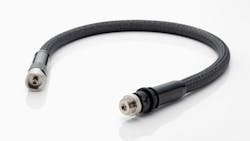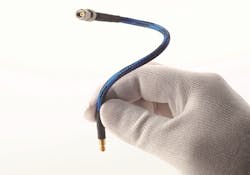The Role of Innovative Cabling in a 5G Future
What you’ll learn:
- The evolving status of 5G and mmWave’s role in the technology.
- Cabling solutions for 5G test.
- What probe stations need to meet 5G test demands.
Test and measurement is a crucial component of cabling innovations. As we move toward a 5G-enabled world, the cables and interconnects used in test and measurement processes must be of the highest standard and reliability.
5G represents the next major evolution of mobile communication technology and is enabling next-generation applications such as the Internet of Things, autonomous vehicles, and virtual reality. It does, however, bring significant hurdles to overcome. For example, spectrum availability is limited and, as a result, 5G must operate at even higher frequencies to deliver the faster data speeds.
This brings into play the mmWave band, which has its own unique challenges such as reliability and ruggedness of cabling. To that end, Junkosha is developing a new generation of cables and interconnects that will stand up to these rigors of higher frequencies and operate efficiently in environments with high flexure and temperature change. Indeed, the key differentiator is phase/amplitude stability over temperature changes, especially in a room temperature of 19˚C (the PTFE knee).
Status of 5G
The development of 5G technology has evolved rather rapidly over the past few years, with networks launching all over the world. Though many rollout schedules have been delayed due to COVID-19, networks continue to expand, and the latest forecasts predict that there will be almost two billion 5G subscriptions worldwide by 2024.1
In the U.S., each of the main four carriers (Verizon, T-Mobile/Sprint, and AT&T) offer 5G connectivity. Verizon launched its 5G mobile network at the start of April 2019, becoming the first carrier in the world to offer the next-generation network. At the start of 2021, Verizon’s 5G Ultra-Wideband mmWave network covered more than 60 U.S. cities.
In the U.K., EE was the first network to launch 5G in May 2019, closely followed by Vodafone and O2. As of January 2021, EE’s 5G service had expanded to 125 towns and cities across the U.K., with Virgin Media beginning its rollout in the same month to join the growing list of providers.
The strategies behind 5G deployment vary significantly: Some operators utilize ultra-high-speed but low-area mmWave technology, while others opt for sub-600-MHz frequencies that have greater reach but deliver lower speeds. There are also those that sit in the mid-band area of 2.5 GHz. Regardless of the underlying strategy, users of any 5G network can expect faster speeds than any previous generation of cellular technology.
An Overview of mmWave
Thanks to the development of 5G, the demand for mmWave frequencies is no longer the preserve of military and space-age applications; instead, it’s now being demanded in mainstream technologies. Because the relevant section of the spectrum is mostly unused, mmWave technologies aim to increase the amount of bandwidth available over small, densely populated areas where data congestion is high. Its short wavelength also enables faster data transfer.
For systems to deliver the required outputs at the higher mmWave frequency, their cabling and interconnects must adhere to the statement “phase performance that endures,” especially in the test and measurement environment. At these frequencies, interconnects are very small, which means connector design is a complicated task. Furthermore, the bending and stress experienced by the cabling is significant relative to the very small wavelengths involved, resulting in an environment that demands phase-stable cables.
The broad deployment of 5G networks necessitate sophisticated instrumentation and cabling of the highest quality to ensure the faster connections, higher throughput, and greater capacity inherent in the promise of 5G. Interconnects are often considered the weakest link of a system and remain the most critical element in terms of reliability. Hence, it’s crucial that engineers use cabling and interconnects that have been built for the 5G world.
The Role of Innovative Cabling
Over the last 18 months, Junkosha has launched several high-end mmWave cabling solutions. Featuring the highest-performing dielectric material and high flex life thanks to precision engineered expanded-PTFE (ePTFE) tape-wrapping technology, each is designed to withstand the most rigorous of testing environments.
Cabling assemblies deployed in a test environment are often utilized alongside vector network analyzers (VNAs). Such equipment is used to test and characterize components to ensure systems function together efficiently. At mmWave’s miniaturized wavelengths, instances of flexure and movement have a significant impact on the accuracy of results, which is accentuated as frequencies increase.
Accuracy is crucial in any test setting, but particularly so for metrology-grade cabling, which offers ultimate precision and therefore demands the highest reliability for testing and calibration purposes. In such use cases, it’s important to deploy properly designed microwave/mmWave VNA test cable assemblies (Fig. 1) intended for use by those requiring optimum precision, such as top-level national institutes and calibration laboratories.
Cables of this caliber exhibit excellent phase and amplitude stability in flexure alongside strong phase stability in temperature. Reaching 50 GHz and available with a 2.4-mm connector, the assembly displays impressive performance durability with flexibility and no spring back. A ruggedized port-side NMD connector ensures reliable connections to the VNA.
In a 5G future where both humans and devices will require constant wireless connectivity, the world demands more efficient use of the available frequency spectrum through innovative technologies. These high-quality cables provide VNA manufacturers with the capability to test the high-frequency networks that are at the heart of tomorrow’s highly sophisticated systems.
Probe Stations
Probe stations enable a user to position electrical, optical, or RF probes on a silicon wafer and connect them to a VNA so that the device can be tested. Using high-end cabling in a probe station is crucial—cables must be low loss, lightweight, and both phase and amplitude stable against temperature, flexure, and vibration. This is because once calibrated, the cable must function accurately for a long period of time. If the cable isn’t phase stable, it can quickly degrade a system, producing inaccurate data and requiring regular recalibration.
A further important consideration is the connectors, which help to keep the probe tip (that needs micrometer accuracy) stable. Many applications require bending in the cable, which makes the angle of the connector crucial so that the probe tip is kept in position.
Research forecasts that the global high-frequency probe-station market will be worth $1176.3 million by 2025,2 primarily driven by the accelerating 5G deployment. Indeed, as 5G continues to be rolled out, applications requiring high-quality microchips increase and so does the need for probe stations to test chips packaged together. In wafer probe testing, chips are mounted together and tested for functionality as a complete solution.
With chips operating at higher frequencies, cables must transfer the signals onto and out of the chips at a faster rate. To meet this requirement, the highest-quality cables are essential. Again, cables with an ePTFE tape-wrapped dielectric layer offer the ability to build with controlled tension, thickness, mechanical ability, and flexibility.
An example of such a cable, Junkosha’s MWX001 cable assembly (Fig. 2), features extremely low insertion loss for measuring applications requiring flexibility. As a result, it’s increasingly becoming the system of choice for probe stations. Cable insertion loss is minimized due to its cable structure, which is optimized for measurement up to 110 GHz.
Such cable assemblies also exhibit excellent phase stability, high-quality signal transmission, and strong ability to sustain form. A safety-lock mechanism ensures that the 1.0-mm connector pin is safely and surely inserted into the female connector.
As 5G interconnects devices, machines, and people closer than ever before, each new level of advanced technology brings more sophisticated chipsets. And, therefore, it further drives the need for efficient probe station testing and high-end cabling.
Looking to the Future
We’re looking at a future centered around connected devices that demand reduced latency to fulfill real-time applications. Research commissioned by Qualcomm from ABI Research anticipates that 5G represents approximately a 10X decrease in latency compared to previous cellular generations, alongside an improved data rate.
Cable-assembly makers like Junkosha are frequently asked for cabling and interconnect solutions that surpass current speeds and frequencies, moving us to a world we can hardly imagine. However, with significant changes come significant challenges. Test and measurement processes are consistently becoming more demanding, highlighting why cabling and interconnect solutions must be the focus of future innovation.
References:
About the Author
Masaru Omoto
Microwave Product Manager, Junkosha
Masaru Omoto, Microwave Product Manager, has been with Junkosha for over 10 years and is an integral part of the international development team that consistently delivers market-leading innovations to provide “phase performance that endures.”


